Synchronous Shot Peening Applied on HVOF for Improvement on Wear Resistance of Fe-based Amorphous Coating
Abstract
1. Introduction
2. Experimental Procedures
2.1. Preparation of Coatings
2.2. Measurement and Analysis Method
3. Results and Discussion
3.1. Phase Structure and Residual Stress
3.2. Shot Peening Traces
3.3. Micromorphologies and Mechanical Properties
3.4. Wear Behavior
3.4.1. Friction Coefficient and Wear Rate
3.4.2. Wear Mechanics
3.4.3. Effect of the Compressive Residual Stress
4. Conclusions
Author Contributions
Funding
Conflicts of Interest
References
- Muthu, S.M. Investigations of hot corrosion resistance of hvof coated fe based superalloy a-286 in simulated gas turbine environment. Eng. Fail. Anal. 2020, 107, 104224. [Google Scholar] [CrossRef]
- Zhang, C.; Zhang, Z.-W.; Chen, Q.; Liu, L. Effect of hydrostatic pressure on the corrosion behavior of hvof-sprayed fe-based amorphous coating. J. Alloys Compd. 2018, 758, 108–115. [Google Scholar] [CrossRef]
- Guo, R.Q.; Zhang, C.; Chen, Q.; Yang, Y.; Li, N.; Liu, L. Study of structure and corrosion resistance of fe-based amorphous coatings prepared by hvaf and hvof. Corros. Sci. 2011, 53, 2351–2356. [Google Scholar] [CrossRef]
- Qiao, L.; Wu, Y.; Hong, S.; Zhang, J.; Shi, W.; Zheng, Y. Relationships between spray parameters, microstructures and ultrasonic cavitation erosion behavior of hvof sprayed fe-based amorphous/nanocrystalline coatings. Ultrason. Sonochem. 2017, 39, 39–46. [Google Scholar] [CrossRef]
- Liang, X.B.; Shang, J.C.; Chen, Y.X.; Zhou, Z.D.; Zhang, Z.B.; Xu, B.S. Influence of ceramic particles and process parameters on residual stress of flame-sprayed fe-based coatings. Surf. Coat. Technol. 2018, 354, 10–17. [Google Scholar] [CrossRef]
- Peng, Y.; Zhang, C.; Zhou, H.; Liu, L. On the bonding strength in thermally sprayed fe-based amorphous coatings. Surf. Coat. Technol. 2013, 218, 17–22. [Google Scholar] [CrossRef]
- Zheng, Z.B.; Zheng, Y.G.; Sun, W.H.; Wang, J.Q. Effect of heat treatment on the structure, cavitation erosion and erosion–corrosion behavior of fe-based amorphous coatings. Tribol. Int. 2015, 90, 393–403. [Google Scholar] [CrossRef]
- Terajima, T.; Takeuchi, F.; Nakata, K.; Adachi, S.; Nakashima, K.; Igarashi, T. Composite coating containing wc/12co cermet and fe-based metallic glass deposited by high-velocity oxygen fuel spraying. J. Alloys Compd. 2010, 504, S288–S291. [Google Scholar] [CrossRef]
- Yugeswaran, S.; Kobayashi, A.; Suresh, K.; Subramanian, B. Characterization of gas tunnel type plasma sprayed tin reinforced fe-based metallic glass coatings. J. Alloys Compd. 2013, 551, 168–175. [Google Scholar] [CrossRef]
- Zhang, C.; Zhou, H.; Liu, L. Laminar fe-based amorphous composite coatings with enhanced bonding strength and impact resistance. Acta Mater. 2014, 72, 239–251. [Google Scholar] [CrossRef]
- Bansal, P.; Shipway, P.H.; Leen, S.B. Residual stresses in high-velocity oxy-fuel thermally sprayed coatings—Modelling the effect of particle velocity and temperature during the spraying process. Acta Mater. 2007, 55, 5089–5101. [Google Scholar] [CrossRef]
- Suhonen, T.; Varis, T.; Dosta, S.; Torrell, M.; Guilemany, J.M. Residual stress development in cold sprayed al, cu and ti coatings. Acta Mater. 2013, 61, 6329–6337. [Google Scholar] [CrossRef]
- Zhang, X.; Watanabe, M.; Kuroda, S. Effects of processing conditions on the mechanical properties and deformation behaviors of plasma-sprayed thermal barrier coatings: Evaluation of residual stresses and mechanical properties of thermal barrier coatings on the basis of in situ curvature measurement under a wide range of spray parameters. Acta Mater. 2013, 61, 1037–1047. [Google Scholar]
- Ghelichi, R.; Bagherifard, S.; MacDonald, D.; Fernandez-Pariente, I.; Jodoin, B.; Guagliano, M. Experimental and numerical study of residual stress evolution in cold spray coating. Appl. Surf. Sci. 2014, 288, 26–33. [Google Scholar] [CrossRef]
- Kuroda, S.; Tashiro, Y.; Yumoto, H.; Taira, S.; Fukanuma, H.; Tobe, S. Peening action and residual stresses in high-velocity oxygen fuel thermal spraying of 316l stainless steel. J. Therm. Spray Technol. 2001, 10, 367–374. [Google Scholar] [CrossRef]
- Wang, Y.; Li, K.Y.; Scenini, F.; Jiao, J.; Qu, S.J.; Luo, Q.; Shen, J. The effect of residual stress on the electrochemical corrosion behavior of fe-based amorphous coatings in chloride-containing solutions. Surf. Coat. Technol. 2016, 302, 27–38. [Google Scholar] [CrossRef]
- Zoei, M.S.; Sadeghi, M.H.; Salehi, M. Effect of grinding parameters on the wear resistance and residual stress of hvof-deposited wc–10co–4cr coating. Surf. Coat. Technol. 2016, 307, 886–891. [Google Scholar] [CrossRef]
- Abubakar, A.A.; Arif, A.F.M.; Al-Athel, K.S.; Akhtar, S.S.; Mostaghimi, J. Modeling residual stress development in thermal spray coatings: Current status and way forward. J. Spray Technol. 2017, 26, 1115–1145. [Google Scholar] [CrossRef]
- Luo, W.; Selvadurai, U.; Tillmann, W. Effect of residual stress on the wear resistance of thermal spray coatings. J. Spray Technol. 2015, 25, 321–330. [Google Scholar] [CrossRef]
- Staia, M.H.; Ramos, E.; Carrasquero, A.; Roman, A.; Lesage, J.; Chicot, D.; Mesmacque, G. Effect of substrate roughness induced by grit blasting upon adhesion of wc-17% co thermal sprayed coatings. Thin Solid Film 2000, 377–378, 657–664. [Google Scholar] [CrossRef]
- Wang, Y.Y.; Li, C.J.; Ohmori, A. Influence of substrate roughness on the bonding mechanisms of high velocity oxy-fuel sprayed coatings. Thin Solid Film. 2005, 485, 141–147. [Google Scholar] [CrossRef]
- Junior, G.S.; Voorwald, H.J.C.; Vieira, L.F.S.; Cioffi, M.O.H.; Bonora, R.G. Evaluation of wc-10ni thermal spray coating with shot peening on the fatigue strength of aisi 4340 steel. Procedia Eng. 2010, 2, 649–656. [Google Scholar] [CrossRef]
- Moridi, A.; Hassani-Gangaraj, S.M.; Vezzú, S.; Trško, L.; Guagliano, M. Fatigue behavior of cold spray coatings: The effect of conventional and severe shot peening as pre-/post-treatment. Surf. Coat. Technol. 2015, 283, 247–254. [Google Scholar] [CrossRef]
- Unal, O.; Varol, R. Surface severe plastic deformation of aisi 304 via conventional shot peening, severe shot peening and repeening. Appl. Surf. Sci. 2015, 351, 289–295. [Google Scholar] [CrossRef]
- Singer, A.R.E. Simultaneous spray deposition and peening of metals (ssp). Met. Technol. 1984, 11, 99–104. [Google Scholar] [CrossRef]
- Chen, Y.; Liang, X.; Liu, Y.; Xu, B. Elastoplastic analysis of process induced residual stresses in thermally sprayed coatings. J. Appl. Phys. 2010, 108, 49. [Google Scholar]
- Chen, Y.; Shang, J.; Liang, X.; Wang, H.; Zhou, Z. Warm-particle peening assisted hvof spraying: A new process to improve the coating performances. Surf. Coat. Technol. 2019, 367, 135–147. [Google Scholar] [CrossRef]
- Zhang, P.; Lindemann, J. Influence of shot peening on high cycle fatigue properties of the high-strength wrought magnesium alloy az80. Scr. Mater. 2005, 52, 485–490. [Google Scholar] [CrossRef]
- Wagner, L. Mechanical surface treatments on titanium, aluminum and magnesium alloys. Mater. Sci. Eng. A 1999, 263, 210–216. [Google Scholar] [CrossRef]
- Ivosevic, M.; Gupta, V.; Baldoni, J.A.; Cairncross, R.A.; Twardowski, T.E.; Knight, R. Effect of substrate roughness on splatting behavior of hvof sprayed polymer particles: Modeling and experiments. J. Spray Technol. 2006, 15, 725–730. [Google Scholar] [CrossRef]
- Li, C.-J.; Li, C.-X.; Yang, G.-J.; Wang, Y.-Y. Examination of substrate surface melting-induced splashing during splat formation in plasma spraying. J. Spray Technol. 2006, 15, 717–724. [Google Scholar] [CrossRef]
- Sun, T.; Liu, J.; Yan, H.; Morgan, G.; Chen, W. Super-resolution reconstruction based on incoherent optical aperture synthesis. Opt. Lett. 2013, 38, 3471–3474. [Google Scholar] [CrossRef] [PubMed]
- Pan, J.; Hu, S.; Yang, L.; Ding, K.; Ma, B. Numerical analysis of flame and particle behavior in an hvof thermal spray process. Mater. Desig. 2016, 96, 370–376. [Google Scholar] [CrossRef]
- Al-Obaid, Y.F. Shot peening mechanics: Experimental and theoretical analysis. Mech. Mater. 1995, 19, 251–260. [Google Scholar] [CrossRef]
- Choi, E.Y.; Kang, M.C.; Kwon, D.H.; Shin, D.W.; Kim, K.H. Comparative studies on microstructure and mechanical properties of crn, cr–c–n and cr–mo–n coatings. J. Mater. Process. Technol. 2007, 187–188, 566–570. [Google Scholar]
- Gao, M.; Lu, W.; Yang, B.; Zhang, S.; Wang, J. High corrosion and wear resistance of al-based amorphous metallic coating synthesized by hvaf spraying. J. Alloys Compd. 2018, 735, 1363–1373. [Google Scholar] [CrossRef]
- Pappacena, K.E.; Singh, D.; Ajayi, O.O.; Routbort, J.L.; Erilymaz, O.L.; Demas, N.G.; Chen, G. Residual stresses, interfacial adhesion and tribological properties of mon/cu composite coatings. WEAR 2012, 278–279, 62–70. [Google Scholar] [CrossRef]
- Gao, C.; Bhushan, B. Tribological performance of magnetic thin-film glass disks: Its relation to surface roughness and lubricant structure and its thickness. WEAR 1995, 190, 60–75. [Google Scholar] [CrossRef]
- Zhou, Z.; Liang, X.; Chen, Y.; Shen, B.; Shang, J.; Cai, Z. Effects of al addition on microstructure and wear resistance of high-velocity-oxygen-fuel-sprayed feconicrmn high entropy alloy coating. Sci. Adv. Mater. 2019, 11, 685–693. [Google Scholar] [CrossRef]
- Lin, N.; Xie, F.; Yang, H.; Tian, W.; Wang, H.; Tang, B. Assessments on friction and wear behaviors of p110 steel and chromizing coating sliding against two counterparts under dry and wet conditions. Appl. Surf. Sci. 2012, 258, 4960–4970. [Google Scholar] [CrossRef]
- Sharma, S.P.; Dwivedi, D.K.; Jain, P.K. Effect of la2o3 addition on the microstructure, hardness and abrasive wear behavior of flame sprayed ni based coatings. WEAR 2009, 267, 853–859. [Google Scholar] [CrossRef]
- Tao, Y.-F.; Li, J.; Lv, Y.-H.; Hu, L.-F. Effect of heat treatment on residual stress and wear behaviors of the tini/ti 2 ni based laser cladding composite coatings. Opt. Laser Technol. 2017, 97, 379–389. [Google Scholar] [CrossRef]
- Maupin, H.; Wilson, R.; Hawk, J. Wear deformation of ordered fe-al intermetallic alloys. WEAR 1993, 162, 432–440. [Google Scholar] [CrossRef]
- Pavlina, E.J.; Van Tyne, C.J. Correlation of yield strength and tensile strength with hardness for steels. J. Mater. Eng. Perform. 2008, 17, 888–893. [Google Scholar] [CrossRef]
- Cheng, J.B.; Liang, X.B.; Wang, Z.H.; Xu, B.S. Microstructure and mechanical properties of febsinb metallic glass coatings by twin wire arc spraying. J. Spray Technol. 2013, 22, 471–477. [Google Scholar] [CrossRef]
- Cao, Y.J.; Sun, J.Q.; Ma, F.; Chen, Y.Y.; Cheng, X.Z.; Gao, X.; Xie, K. Effect of the microstructure and residual stress on tribological behavior of induction hardened gcr15 steel. Tribol. Int. 2017, 115, 108–115. [Google Scholar] [CrossRef]
- Goto, H.; Amamoto, Y. Effect of varying load on wear resistance of carbon steel under unlubricated conditions. WEAR 2003, 254, 1256–1266. [Google Scholar] [CrossRef]
- Keshri, A.K.; Agarwal, A. Wear behavior of plasma-sprayed carbon nanotube-reinforced aluminum oxide coating in marine and high-temperature environments. J. Spray Technol. 2011, 20, 1217–1230. [Google Scholar] [CrossRef]
- Wang, Y.; Pan, Z.; Wang, Z.; Sun, X.; Wang, L. Sliding wear behavior of cr–mo–cu alloy cast irons with and without nano-additives. WEAR 2011, 271, 2953–2962. [Google Scholar] [CrossRef]
- Holmberg, K.; Ronkainen, H.; Laukkanen, A.; Wallin, K.; Hogmark, S.; Jacobson, S.; Wiklund, U.; Souza, R.M.; Ståhle, P. Residual stresses in tin, dlc and mos2 coated surfaces with regard to their tribological fracture behaviour. WEAR 2009, 267, 2142–2156. [Google Scholar] [CrossRef]
- Laukkanen, A.; Holmberg, K.; Koskinen, J.; Ronkainen, H.; Wallin, K.; Varjus, S. Tribological contact analysis of a rigid ball sliding on a hard coated surface, part iii: Fracture toughness calculation and influence of residual stresses. Surf. Coat. Technol. 2006, 200, 3824–3844. [Google Scholar] [CrossRef]
- Vierneusel, B.; Benker, L.; Tremmel, S.; Göken, M.; Merle, B. Isolating the effect of residual stresses on coating wear by a mechanical stress relaxation technique. Thin Solid Film. 2017, 638, 159–166. [Google Scholar] [CrossRef]
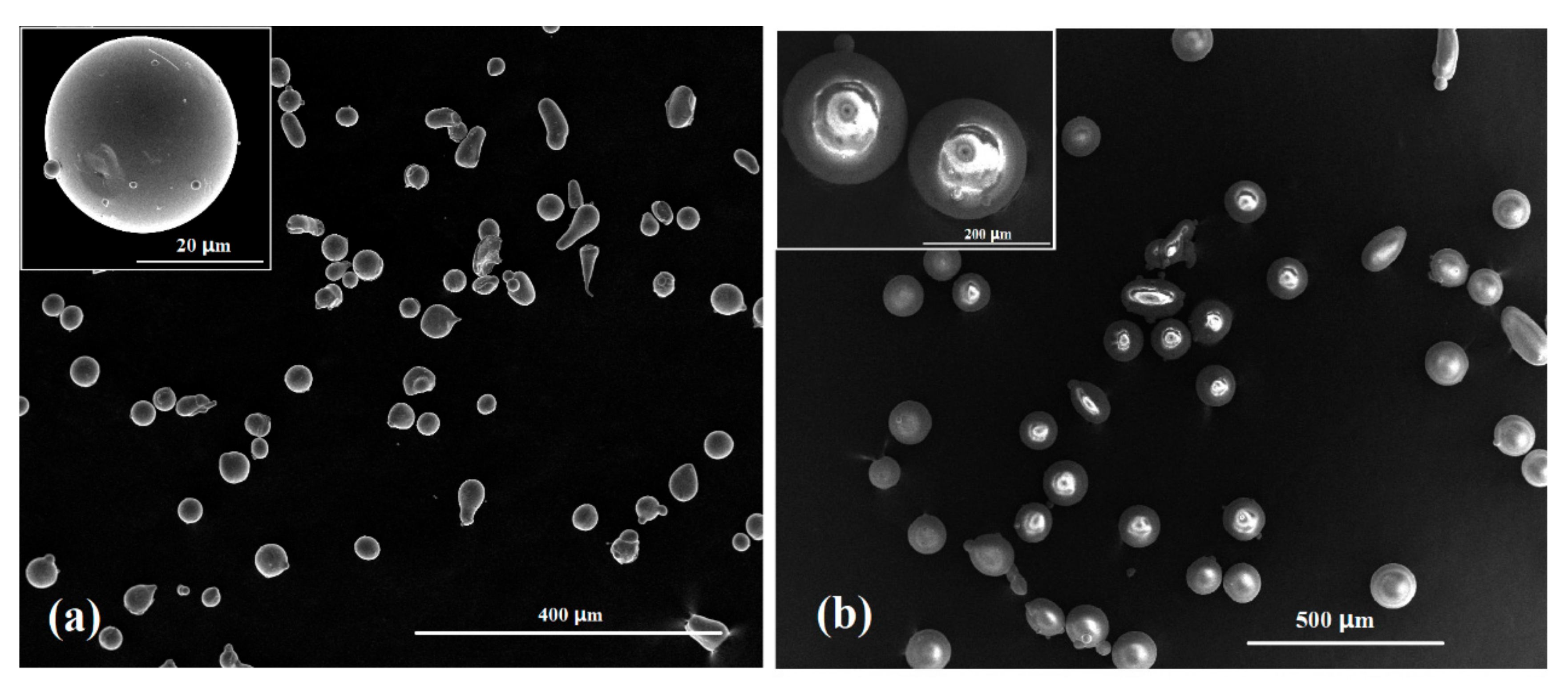
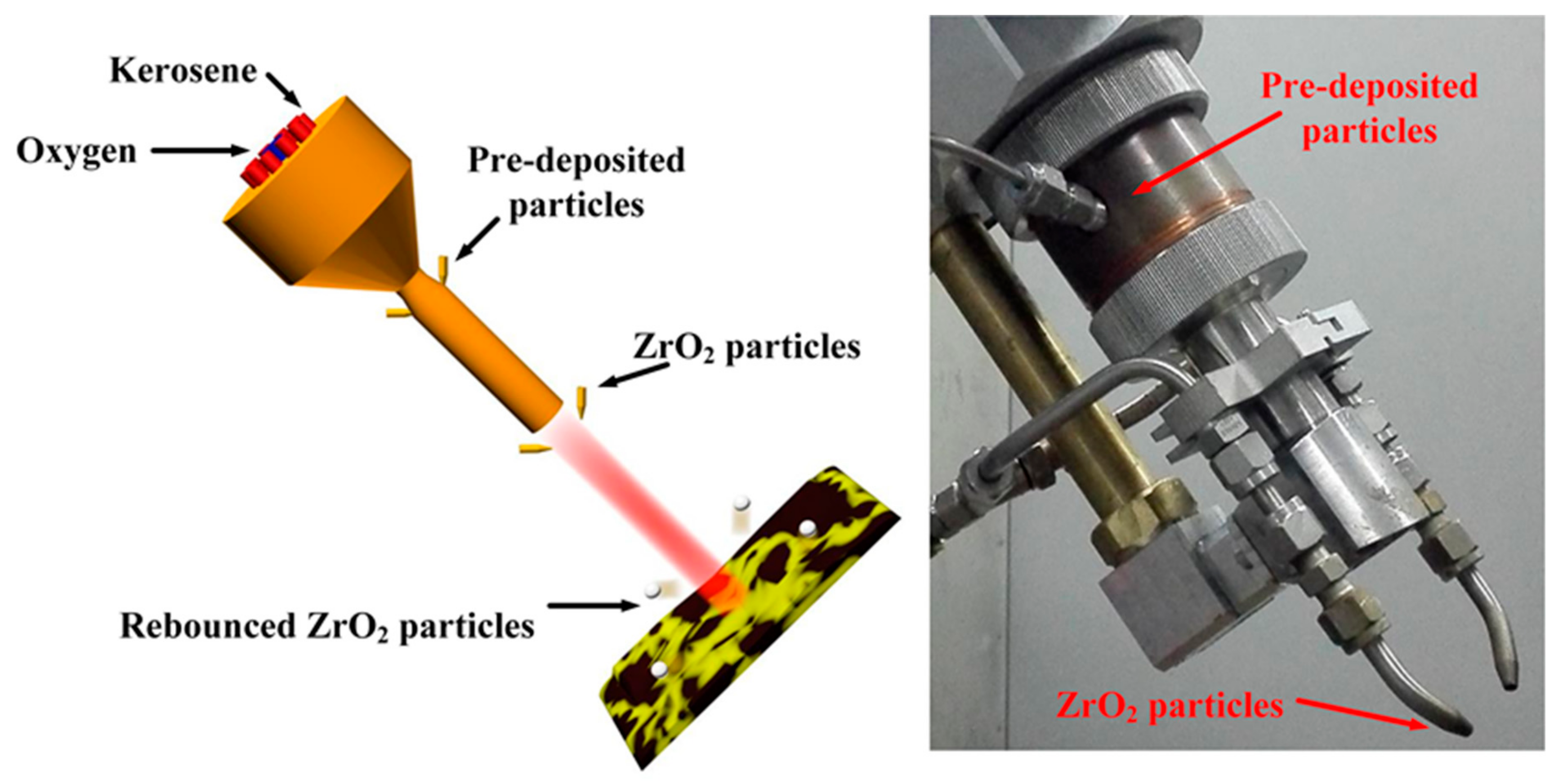

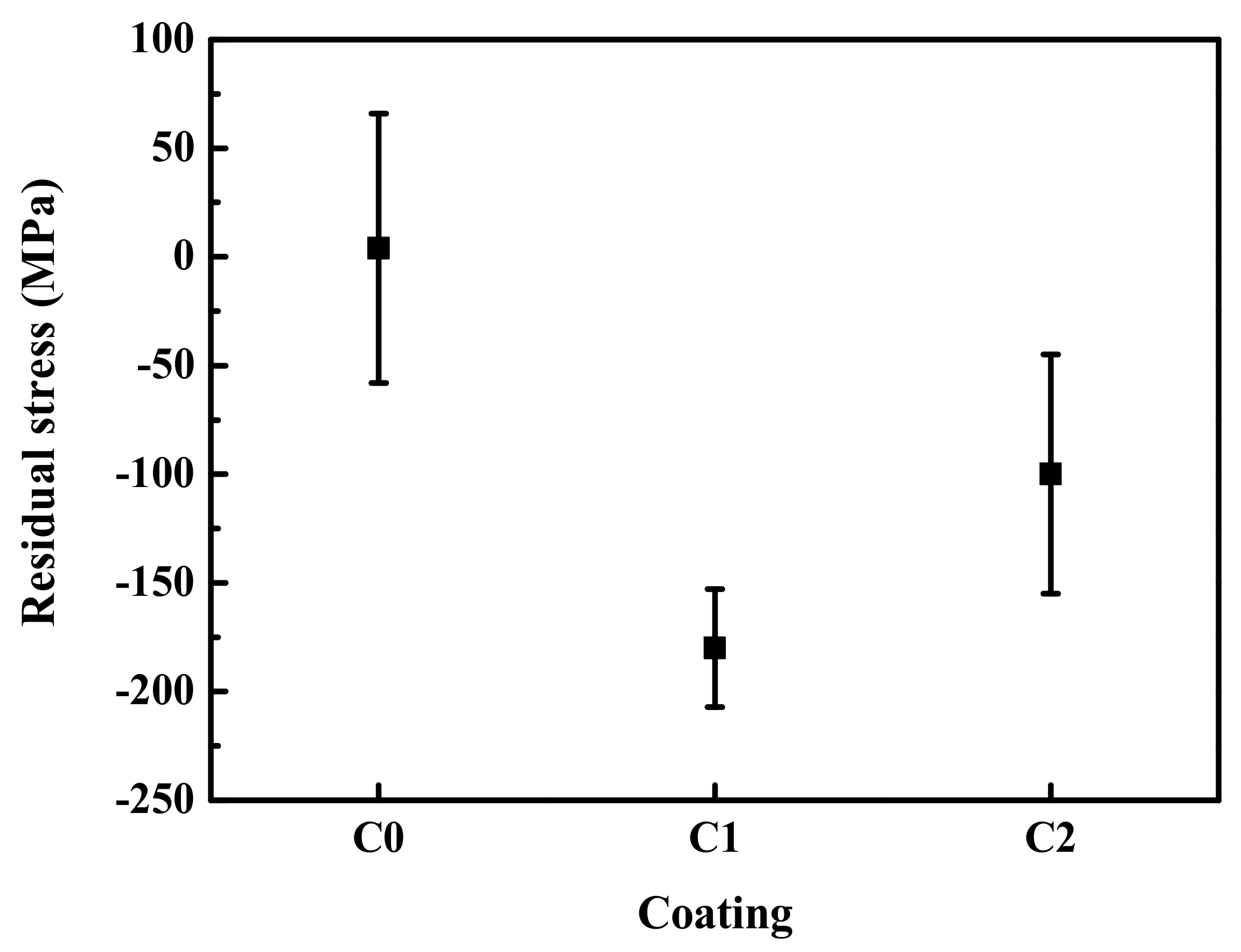
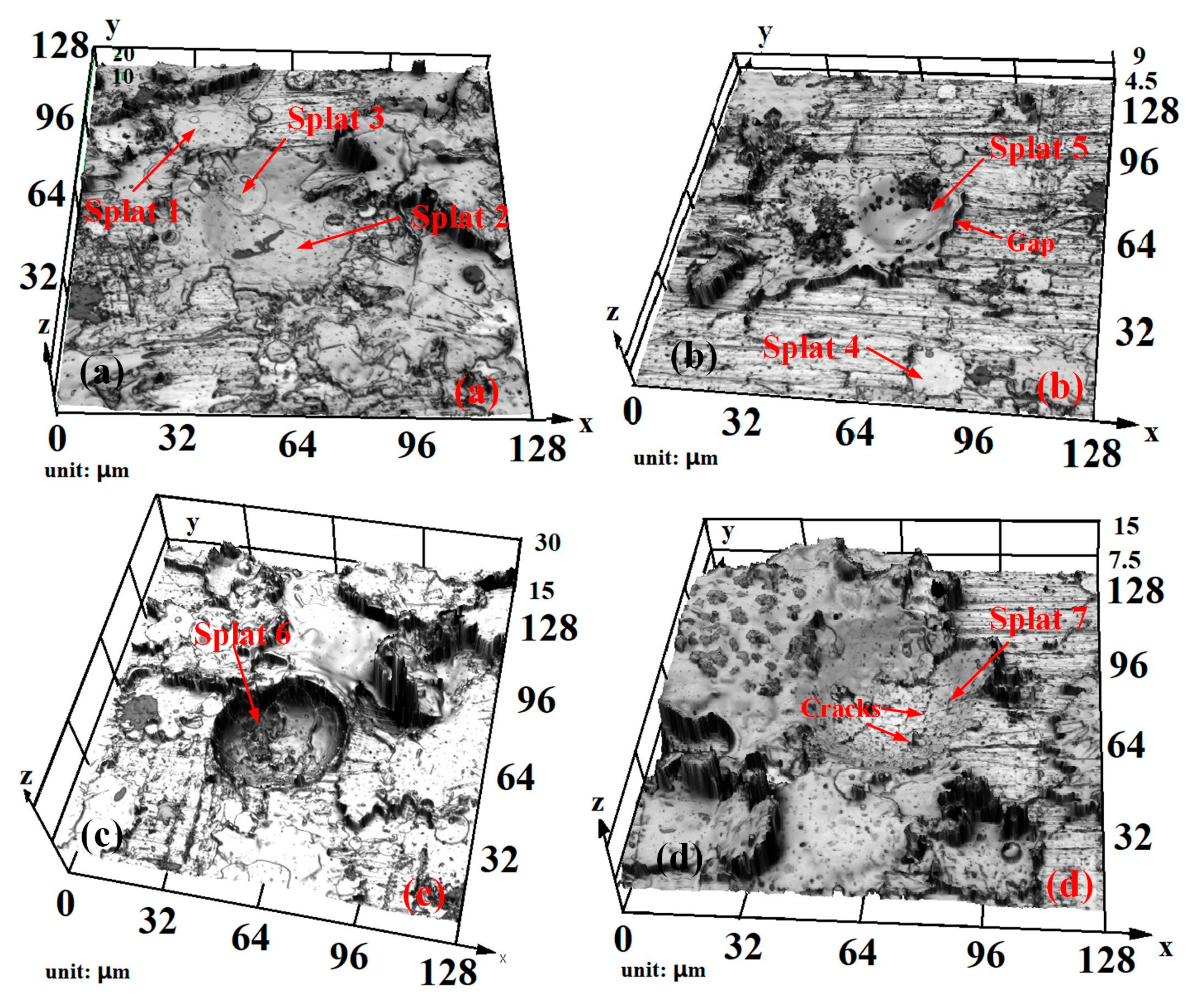

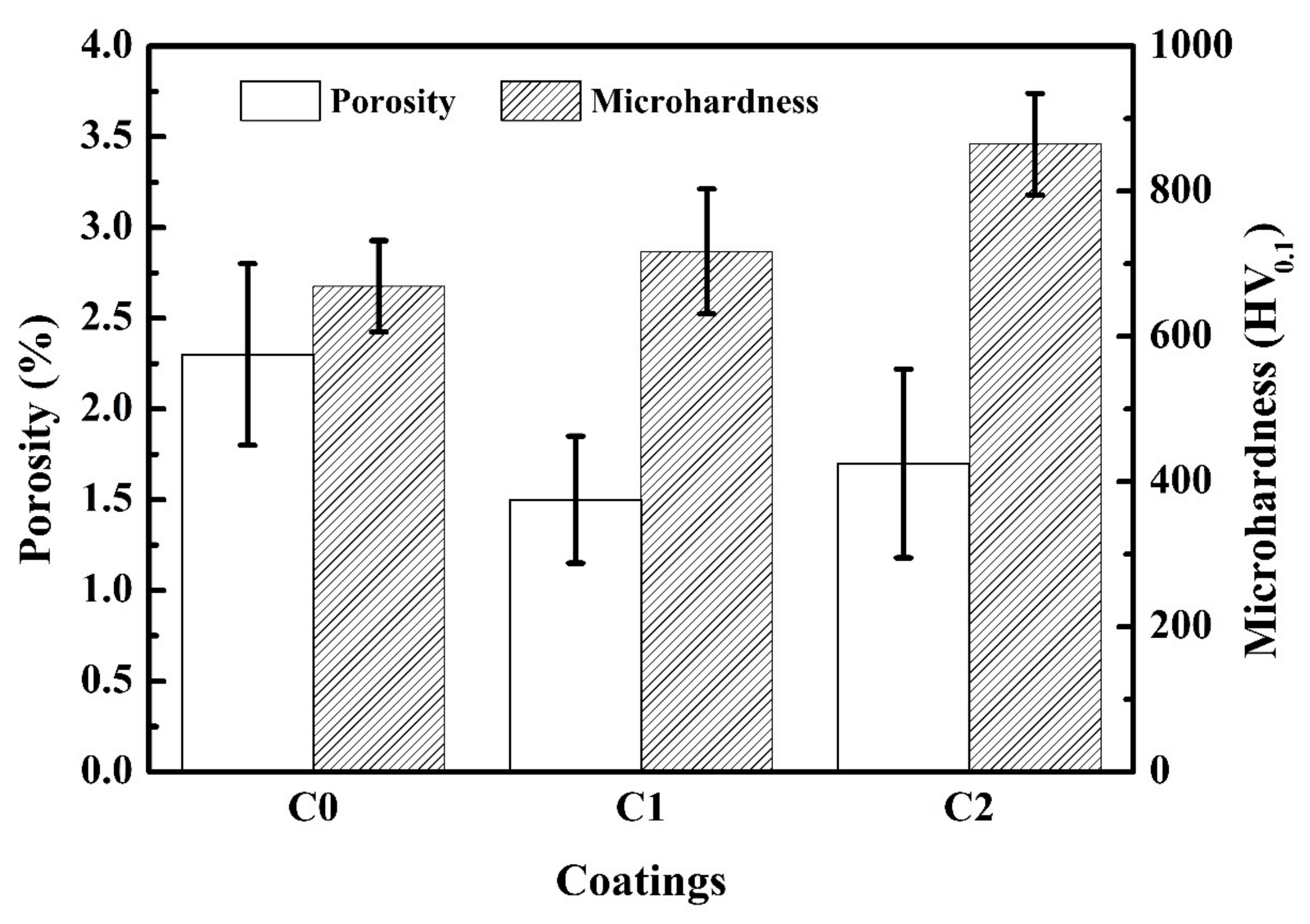

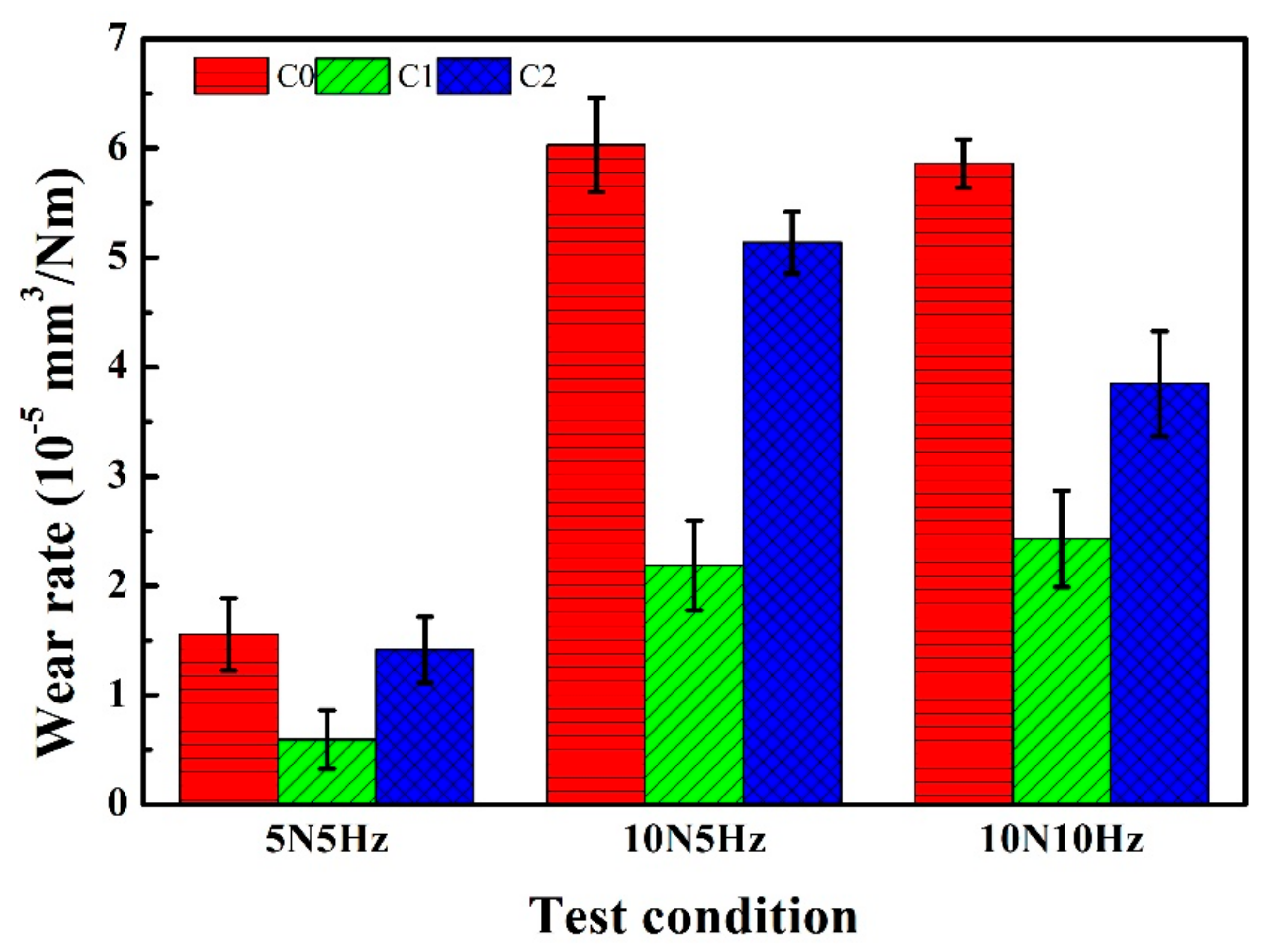

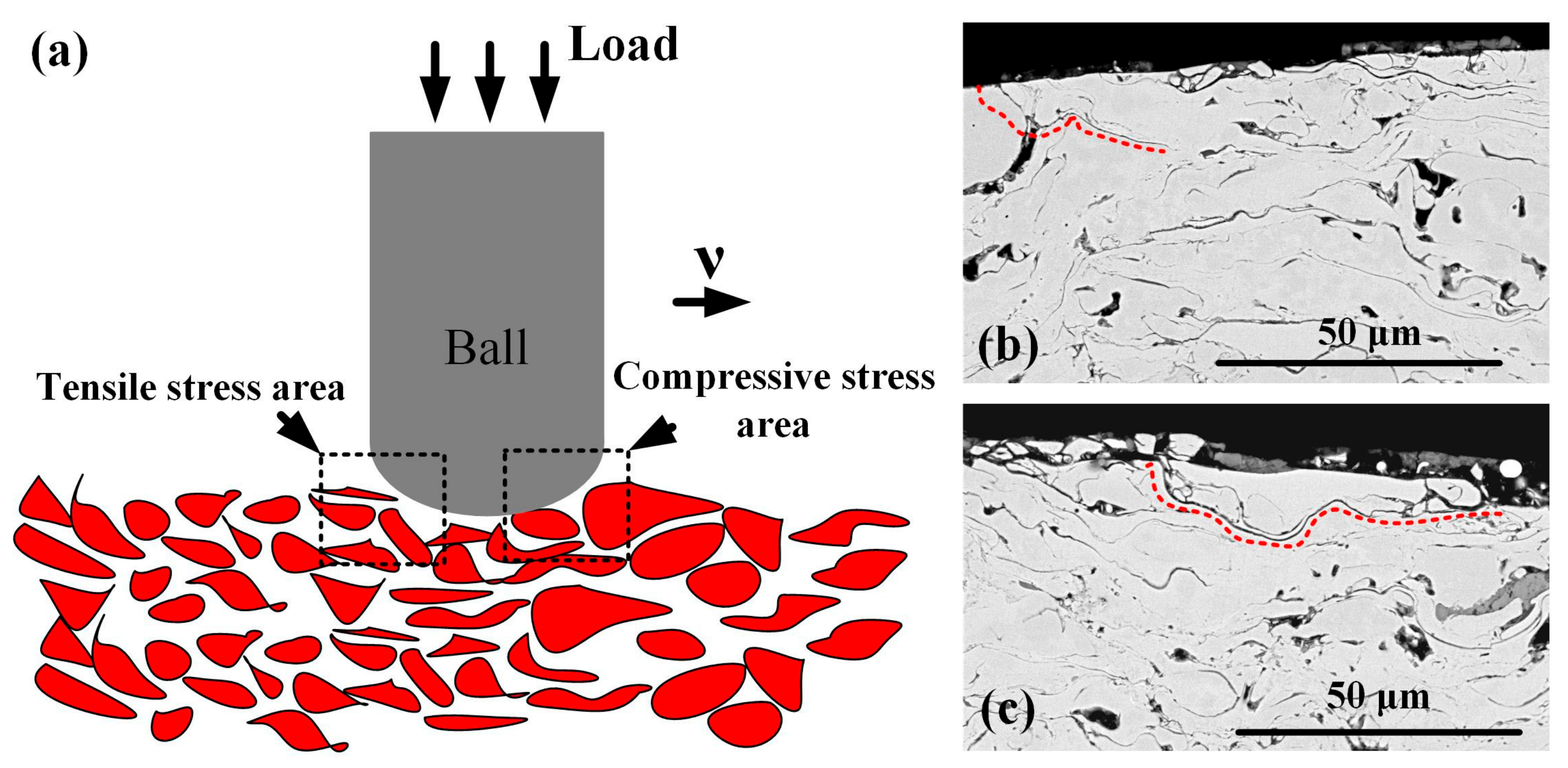
| Parameters | Values | ||
|---|---|---|---|
| C0 | C1 | C2 | |
| Fuel(kerosene) flow (L·h−1) | 23.7 | 23.7 | 23.7 |
| Oxygen gas flow (N·m3·h−1) | 50 | 50 | 50 |
| Oxygen/fuel (vol.%) | 2.1 | 2.1 | 2.1 |
| Combustion chamber pressure (MPa) | 0.8 | 0.8 | 0.8 |
| Powder feeding rate (g·min−1) | 85 | 85 | 85 |
| Spraying distance (mm) | 300 | 300 | 300 |
| Peening particles rate (g·min−1) | 0 | 50 | 150 |
| Element (wt %) | Nb | O | Si | Fe | B | |
|---|---|---|---|---|---|---|
| Area | ||||||
| A | 2.99 | 47.91 | 8.97 | 37.94 | 2.19 | |
| B | 6.71 | 33.88 | 3.01 | 53.33 | 3.07 | |
© 2020 by the authors. Licensee MDPI, Basel, Switzerland. This article is an open access article distributed under the terms and conditions of the Creative Commons Attribution (CC BY) license (http://creativecommons.org/licenses/by/4.0/).
Share and Cite
Zhou, Z.; Shang, J.; Chen, Y.; Liang, X.; Shen, B.; Zhang, Z. Synchronous Shot Peening Applied on HVOF for Improvement on Wear Resistance of Fe-based Amorphous Coating. Coatings 2020, 10, 187. https://doi.org/10.3390/coatings10020187
Zhou Z, Shang J, Chen Y, Liang X, Shen B, Zhang Z. Synchronous Shot Peening Applied on HVOF for Improvement on Wear Resistance of Fe-based Amorphous Coating. Coatings. 2020; 10(2):187. https://doi.org/10.3390/coatings10020187
Chicago/Turabian StyleZhou, Zhidan, Junchao Shang, Yongxiong Chen, Xiubing Liang, Baolong Shen, and Zhibin Zhang. 2020. "Synchronous Shot Peening Applied on HVOF for Improvement on Wear Resistance of Fe-based Amorphous Coating" Coatings 10, no. 2: 187. https://doi.org/10.3390/coatings10020187
APA StyleZhou, Z., Shang, J., Chen, Y., Liang, X., Shen, B., & Zhang, Z. (2020). Synchronous Shot Peening Applied on HVOF for Improvement on Wear Resistance of Fe-based Amorphous Coating. Coatings, 10(2), 187. https://doi.org/10.3390/coatings10020187





